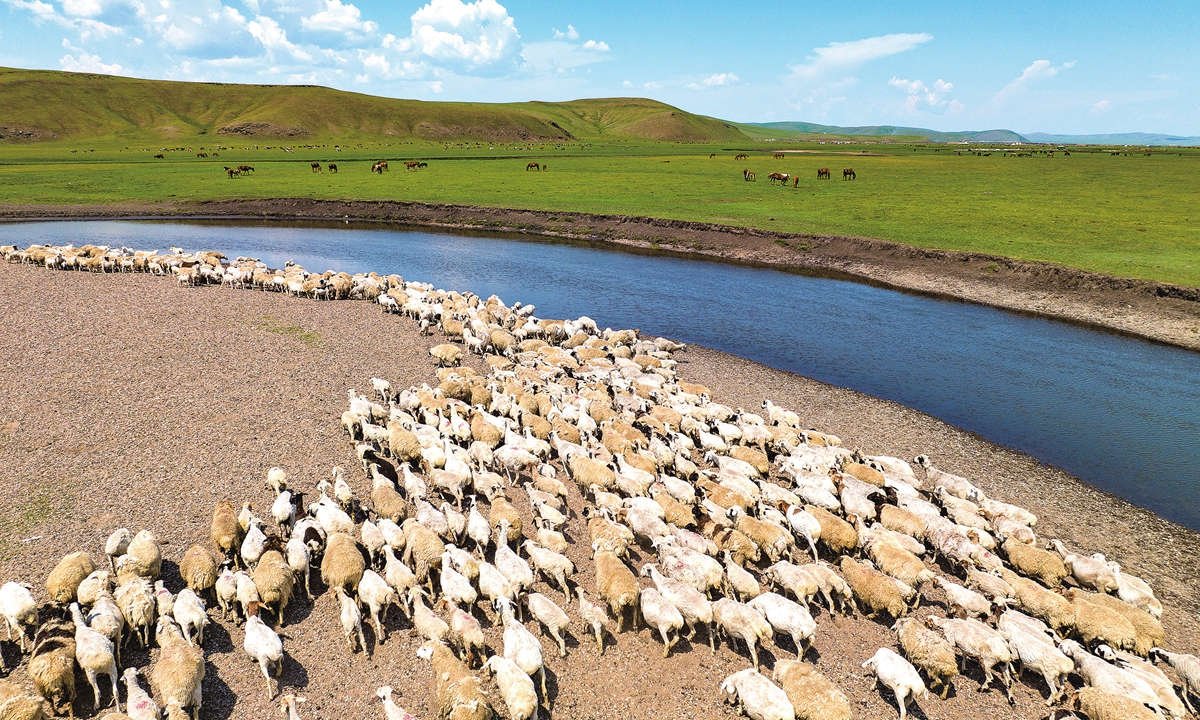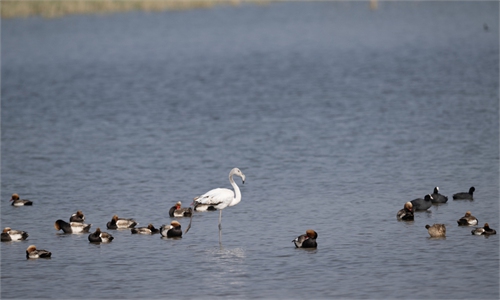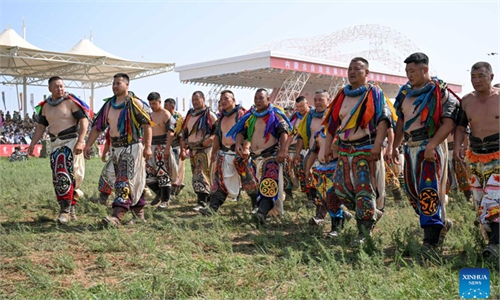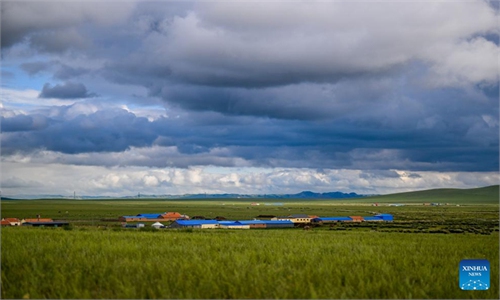ARTS / CULTURE & LEISURE
Hulun Buir Grassland enchanting for pastoral scenery, ethnic unity
Northern China’s jade
During the hot summer months, the Hulun Buir Grassland in North China's Inner Mongolia Autonomous Region is an ideal vacation destination. Known in the 1970s by the popular song "I Love the Grassland of Our Motherland" to some people, this picturesque locale truly embodies its lyrics, which describe the grassland as "endless green waves," and it captivates visitors from across China and beyond.

The Hulun Buir Grassland was named after the Hulun Lake and Buir Lake, which is rarely known to first visitors. According to folklore, in ancient times, a young couple named Hulun and Buir lived harmoniously in a Mongolian tribe.
Their tranquil life was shattered when a demon, wearing two magical pearls on his head, invaded their land and ravaged the grassland. The demon captured the beautiful girl Hulun, prompting Buir to battle the demon fiercely. Hulun then cleverly tricked the demon into giving her a pearl, which she swallowed, turning herself into a lake.
Buir then defeated the demon with the remaining pearl and, finding Hulun had become the goddess to nurture the glassland, consumed the last pearl to lie forever.
The two lakes were thus named, and so the grassland with their names combined.
Breathtaking landscapes
The vastness of the Hulun Buir Grassland is astonishing. Covering 113,000 square kilometers, it is one of the largest grasslands in the world, with 80 percent covered by native pasture. The landscape presents a pastoral dream: flocks of sheep, cows, and horses graze across the broad expanse, interspersed with patches of yellow rape flowers, while rivers meander through the flat terrain.
Driving through the grassland, visitors are enveloped by the expanse of "green waves" rolling gently in the summer breeze, and for city dwellers accustomed to concrete jungles, the natural environment offers a refreshing view.
In addition to the grassland, Hulun Buir features wetlands, forests, rivers, and lakes, boasting China's largest and most intact ecosystem. The white birch forest in Erguna, located in the west of the Greater Khingan Mountains, spans 1,000 hectares.
The tall, slender birch trees provide a perfect oxygen-rich environment. Additionally, here visitors can enjoy the birch tree juice, and smell the fragrances of four seasons crafted by a Mongolian girl who wanted to share the smell of her hometown.
The Erguna National Wetland Park, also in the west of the Greater Khingan, is China's largest and best-preserved wetland, covering 126,000 hectares. It is home to 404 species and serves as a crucial habitat for 20 million birds annually, earning it the title of "First Wetland in Asia."
Ecological protection
In the 1990s, the grassland faced severe challenges, including desertification, loss of biodiversity, and frequent natural disasters due to overgrazing, land reclamation, mining, and global warming.
In response, the Chinese and local governments intensified measures to restore the grassland.
These included providing ecological subsidies, balancing forage and livestock, and rotating grazing fields.
Authorities also boosted efforts to combat harmful practices, improved legal awareness among local herdsmen, and enhanced their herding techniques.
Hulun Lake, the largest lake in northern China and one of the four largest freshwater lakes in the country, serves as the important part of the ecological security in northern China.
The Hulun Buir Nature Reservewas established as a nature reserve in 1986 and upgraded to a national-level reserve in 1992. Since then, the reserve has been better protected.
Unique customs
Hulun Buir's favorable natural conditions have made it a cradle for several ethnic minorities, with the Mongolians being the largest group.
Historically, this region is known as the birthplace of Genghis Khan and traces of the Mongolian leader are prevalent throughout the area: in the Genhe Wetland, an isle shaped like a horse hoof is believed that it was the hoof print of Genghis Khan's horse, while in the city center of Hailar, a grand statue of Genghis Khan and his aides on horseback serves as a city landmark.
The people of the ethnic Mongolian group have been renowned for their equestrian skills throughout history.
A horse-riding performance in a scenic spot of Hulun Buir impressed all the spectators with terrific horseback acrobatics and the dynamic of the horse herd galloping.
In contrast, an evening bonfire party featured the soulful melodies of a musician playing the traditional Mongolian horsehead fiddle.
The gentle tune of "Swan Goose" expresses an ethnic Mongolian's nostaligia while working away from home.
Among other ethnic groups in Hulun Buir are about 1,300 ethnic Russians, who mainly reside in Ehen, China's only ethnic Russian township near the Erguna River.
A woman of Russian ethnicity shared her family's migration story from the late 19th century, when many fled wars and settled near the Erguna River.
Some settlers later married with Russians and had children like the woman's father and mother, becoming the first generation of China's ethnic Russians.
Within their family, there are also different ethnic groups as her son is an ethnic Han.
They celebrate both Chinese and Russian festivals, such as Easter, during which they also invite people of other ethnic groups to join them, such as the Mongolians, the Hui and the Ewenki, forming a big family of ethnic unity.
In the small border town of Shiwei, many inns are designed as Russian-style log cabins - Mukeden - with traditional decorations. Built entirely by hand from white birch wood without nails, these cabins are cool in summer and warm in winter.
Hulun Buir really provides a wealth of unique and unforgettable experiences, truly earning its reputation as the "jade of northern China."

Sheep and horses roam freely across Hulun Buir, one of the world's largest grasslands. Photo: VCG
Rarely known legendThe Hulun Buir Grassland was named after the Hulun Lake and Buir Lake, which is rarely known to first visitors. According to folklore, in ancient times, a young couple named Hulun and Buir lived harmoniously in a Mongolian tribe.
Their tranquil life was shattered when a demon, wearing two magical pearls on his head, invaded their land and ravaged the grassland. The demon captured the beautiful girl Hulun, prompting Buir to battle the demon fiercely. Hulun then cleverly tricked the demon into giving her a pearl, which she swallowed, turning herself into a lake.
Buir then defeated the demon with the remaining pearl and, finding Hulun had become the goddess to nurture the glassland, consumed the last pearl to lie forever.
The two lakes were thus named, and so the grassland with their names combined.
Breathtaking landscapes
The vastness of the Hulun Buir Grassland is astonishing. Covering 113,000 square kilometers, it is one of the largest grasslands in the world, with 80 percent covered by native pasture. The landscape presents a pastoral dream: flocks of sheep, cows, and horses graze across the broad expanse, interspersed with patches of yellow rape flowers, while rivers meander through the flat terrain.
Driving through the grassland, visitors are enveloped by the expanse of "green waves" rolling gently in the summer breeze, and for city dwellers accustomed to concrete jungles, the natural environment offers a refreshing view.
In addition to the grassland, Hulun Buir features wetlands, forests, rivers, and lakes, boasting China's largest and most intact ecosystem. The white birch forest in Erguna, located in the west of the Greater Khingan Mountains, spans 1,000 hectares.
The tall, slender birch trees provide a perfect oxygen-rich environment. Additionally, here visitors can enjoy the birch tree juice, and smell the fragrances of four seasons crafted by a Mongolian girl who wanted to share the smell of her hometown.
The Erguna National Wetland Park, also in the west of the Greater Khingan, is China's largest and best-preserved wetland, covering 126,000 hectares. It is home to 404 species and serves as a crucial habitat for 20 million birds annually, earning it the title of "First Wetland in Asia."
Ecological protection
In the 1990s, the grassland faced severe challenges, including desertification, loss of biodiversity, and frequent natural disasters due to overgrazing, land reclamation, mining, and global warming.
In response, the Chinese and local governments intensified measures to restore the grassland.
These included providing ecological subsidies, balancing forage and livestock, and rotating grazing fields.
Authorities also boosted efforts to combat harmful practices, improved legal awareness among local herdsmen, and enhanced their herding techniques.
Hulun Lake, the largest lake in northern China and one of the four largest freshwater lakes in the country, serves as the important part of the ecological security in northern China.
The Hulun Buir Nature Reservewas established as a nature reserve in 1986 and upgraded to a national-level reserve in 1992. Since then, the reserve has been better protected.
Unique customs
Hulun Buir's favorable natural conditions have made it a cradle for several ethnic minorities, with the Mongolians being the largest group.
Historically, this region is known as the birthplace of Genghis Khan and traces of the Mongolian leader are prevalent throughout the area: in the Genhe Wetland, an isle shaped like a horse hoof is believed that it was the hoof print of Genghis Khan's horse, while in the city center of Hailar, a grand statue of Genghis Khan and his aides on horseback serves as a city landmark.
The people of the ethnic Mongolian group have been renowned for their equestrian skills throughout history.
A horse-riding performance in a scenic spot of Hulun Buir impressed all the spectators with terrific horseback acrobatics and the dynamic of the horse herd galloping.
In contrast, an evening bonfire party featured the soulful melodies of a musician playing the traditional Mongolian horsehead fiddle.
The gentle tune of "Swan Goose" expresses an ethnic Mongolian's nostaligia while working away from home.
Among other ethnic groups in Hulun Buir are about 1,300 ethnic Russians, who mainly reside in Ehen, China's only ethnic Russian township near the Erguna River.
A woman of Russian ethnicity shared her family's migration story from the late 19th century, when many fled wars and settled near the Erguna River.
Some settlers later married with Russians and had children like the woman's father and mother, becoming the first generation of China's ethnic Russians.
Within their family, there are also different ethnic groups as her son is an ethnic Han.
They celebrate both Chinese and Russian festivals, such as Easter, during which they also invite people of other ethnic groups to join them, such as the Mongolians, the Hui and the Ewenki, forming a big family of ethnic unity.
In the small border town of Shiwei, many inns are designed as Russian-style log cabins - Mukeden - with traditional decorations. Built entirely by hand from white birch wood without nails, these cabins are cool in summer and warm in winter.
Hulun Buir really provides a wealth of unique and unforgettable experiences, truly earning its reputation as the "jade of northern China."



